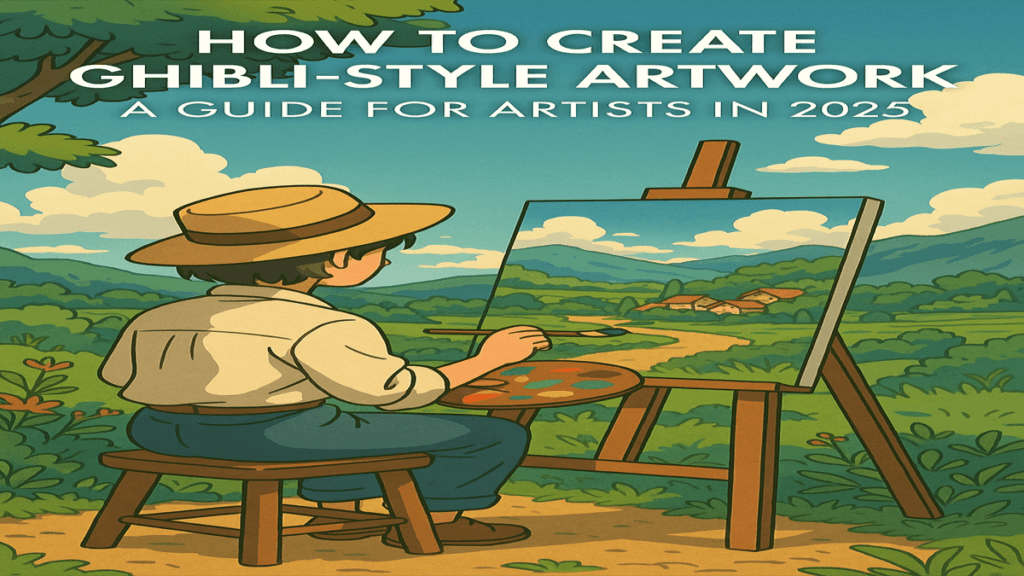Studio Ghibli has mesmerized audiences worldwide with its breathtaking landscapes, dreamy character designs, and rich color palettes. The iconic hand-drawn style pioneered by Hayao Miyazaki and Isao Takahata continues to inspire a new generation of artists. But how do you create Ghibli-style artwork in 2025? This guide will walk you through essential techniques, tools, and tips to bring your illustrations to life with the magic of Ghibli.
1. Understanding the Ghibli Aesthetic
Key Characteristics of Ghibli-Style Art
- Soft and Organic Lines: Unlike rigid digital art styles, Ghibli illustrations feature hand-drawn, slightly imperfect lines that add warmth and personality.
- Rich, Natural Color Palettes: Vibrant yet soft tones dominate Ghibli’s worlds, often inspired by real-life nature and classic watercolor paintings.
- Detailed Backgrounds: Lush forests, intricate architecture, and expansive skies create immersive settings that feel alive.
- Expressive and Simple Character Designs: Characters are expressive yet simple, allowing their emotions and movements to shine without excessive detail.
2. Essential Tools for Ghibli-Style Art in 2025
Traditional & Digital Mediums
While Studio Ghibli primarily used hand-drawn animation, modern artists can achieve the same aesthetic using both traditional and digital tools:
- Traditional: Watercolors, colored pencils, and ink pens (such as Sakura Pigma Microns) for sketching and linework.
- Digital: Software like Procreate, Clip Studio Paint, or Adobe Fresco with textured brushes mimicking real paint.
Brushes & Textures
To capture Ghibli’s organic feel, use:
- Soft Watercolor Brushes – for dreamy backgrounds.
- Chalk or Dry Ink Brushes – for sketchy, hand-drawn textures.
- Cloud and Foliage Brushes – to create soft, atmospheric effects.
3. Mastering Ghibli Background Art
Ghibli landscapes are known for their intricate natural beauty and storybook-like detail. Here’s how to achieve that look:
Study Real-Life References
Ghibli’s art is deeply inspired by real-world locations. Use references from Japanese countryside villages, European architecture, and lush nature scenes.
Layering for Depth
Use foreground, middle ground, and background elements to create a rich, immersive world:
- Foreground: Blurred flowers, trees, or grass to create depth.
- Middle ground: Detailed structures, characters, or objects.
- Background: Soft gradients, atmospheric clouds, and hazy mountains.
Use Light and Shadow Effectively
Ghibli’s artists often use warm, golden lighting to create a dreamlike quality. Incorporate soft sunlight, dappled shadows, and glowing highlights for a nostalgic and magical feel.
4. Creating Ghibli-Inspired Character Designs
Simple Yet Expressive Faces
Ghibli characters typically have:
- Large, expressive eyes with minimal highlights.
- Soft, rounded facial features.
- Simple, natural hairstyles.
- Clothing that fits the world’s aesthetic (vintage, fantasy, or everyday attire).
Storytelling Through Character Poses
Characters in Ghibli films often appear in natural, relaxed poses rather than stiff or overly dramatic ones. Observe real-life movement and try sketching dynamic yet subtle expressions.
5. Adding the Final Touches: The Ghibli Magic
Hand-Painted Textures
Ghibli-style art has an organic, hand-painted look. Avoid overly smooth digital shading by using textured brushes or adding a paper grain overlay.
Use Atmospheric Perspective
To create depth, blur distant objects slightly and make colors fade into soft blues and grays for a painterly effect.
Animate the Environment
If creating an animation, include small movements like:
- Leaves rustling.
- Gentle wind swaying grass.
- Birds flying in the background.
Conclusion: Bring the Ghibli Magic to Your Art
Creating Ghibli-style artwork is about capturing emotion, atmosphere, and storytelling in every brushstroke. Whether painting lush backgrounds or designing simple yet heartfelt characters, embrace the charm of imperfection and the beauty of nature.
By combining traditional techniques with modern tools, studying real-life inspiration, and adding expressive details, you can bring the timeless magic of Ghibli into your own art in 2025 and beyond!
FAQs
Can I create Ghibli-style art digitally?
Yes! Using textured brushes and hand-painted effects in software like Procreate, Photoshop, or Clip Studio Paint can replicate the traditional Ghibli look.
What is the best color palette for Ghibli-style art?
Soft, earthy tones like warm greens, blues, yellows, and browns, inspired by natural landscapes.
How do I improve my background art?
Study Ghibli movie backgrounds, use real-life references, and practice layering to create depth.
What makes Ghibli characters unique?
Simple designs with expressive eyes, soft shading, and natural poses that reflect subtle emotions.
Can I use AI tools to create Ghibli-style art?
While AI can assist, hand-drawn techniques will always capture the warmth and emotion that define Ghibli’s style.
Manikesh Tripathi is a seasoned Top SEO expert, digital strategist, and founder of Latest News Post. With a passion for innovation, he helps businesses dominate search rankings through cutting-edge SEO techniques, AI-driven strategies, and data-backed insights. Stay ahead of the curve with his expert tips, industry trends, and growth hacks.

